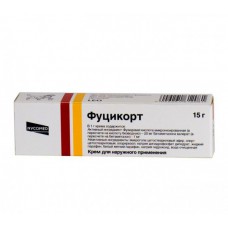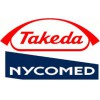Expiration date: 08/2025
The composition and form of issue:
Cream for external use 1 g contains:
fusidic acid (calculated as anhydrous acid) 20 mg
betamethasone valerate (calculated as betamethasone) 1 mg
excipients: macrogol cetostearyl ether cetostearyl alcohol chlorocresol sodium dihydrogen phosphate dihydrate liquid paraffin white soft paraffin sodium hydroxide purified water
in the box to 15 grams in a cardboard bundle 1 tuba.
Description pharmaceutical form:
Smooth cream white color.
Feature:
Combined preparation for external use.
Pharmacokinetics:
In the skin gets 2% of the applied quantity of the drug. When used topically, systemic absorption is low.
Description pharmacological action:
Betamethasone has anti-inflammatory and antipruritic action fusidic acid is an antibacterial.
Highly active against Staphylococcus spp. especially Staphylococcus aureus and Staphylococcus epidermidis (including methicillin-resistant strains), Streptococcus spp., Neisseria spp., Clostridium spp. Nocardia asteroides, Enterococcus spp., Bacteroides spp. Mycobacterium tuberculosis, Mycobacterium leprae and Corynebacterium minutissimum.
Antibacterially the activity of fusidic acid is not reduced in the presence of betamethasone.
Indications:
Dermatitis in the presence of a bacterial infection or suspicion of it: atopic dermatitis, seborrheic dermatitis, irritant contact dermatitis, allergic dermatitis, chronic eczema, lichen red diskoidnaya lupus.
Contraindications:
- hypersensitivity to the drug
- tuberculosis skin
- cutaneous manifestations of syphilis
- varicella
- viral and fungal skin infections
- post-vaccination skin reaction
- open wounds
- trophic ulcers
- rosacea
- acne vulgaris.
Application of pregnancy and breast-feeding:
Experimental studies have shown that the Case does not have embryotoxic and teratogenic. For external use Case selection as fusidic acid, and betamethasone breast milk is unlikely because of low systemic adsorption. Because the study women during pregnancy and lactation have not been conducted in pregnancy, the drug should not be used for a long time and in large quantities, breastfeeding — do not apply the drug on the mammary gland.
Side effects:
Side effects when applied externally are rare and are reversible. As the use of other GCS, in 1-2% of patients may develop a hypersensitivity reaction (itching, burning, redness, tingling, dryness and irritation and rash). Rarely acne-like changes, hypopigmentation, folliculitis, striae, skin atrophy, hypertrichosis, allergic contact dermatitis.
In case of development of hypersensitivity reactions or side effects therapy should be discontinued and consult a doctor!
Drug interactions:
It is not revealed.
Method of application and dose:
Local. Applied to the affected skin thin layer 2 times a day. The course of treatment — 2 weeks.
Overdose:
Symptoms (if you exceed the recommended doses, prolonged use of local corticosteroids on large surfaces): the suppression function of the hypothalamic-pituitary-adrenal axis.
Treatment: it is recommended that gradual withdrawal of the drug, symptomatic therapy, if necessary, a correction of electrolyte balance.
Special instructions:
You should avoid prolonged use of the drug, especially on the face and in skin folds (especially in children) because of the risk of suppression of adrenocortical function. Do not apply the drug in the eye area due to possible development of glaucoma and cataracts, as well as on the wound surface and mucous membranes.



